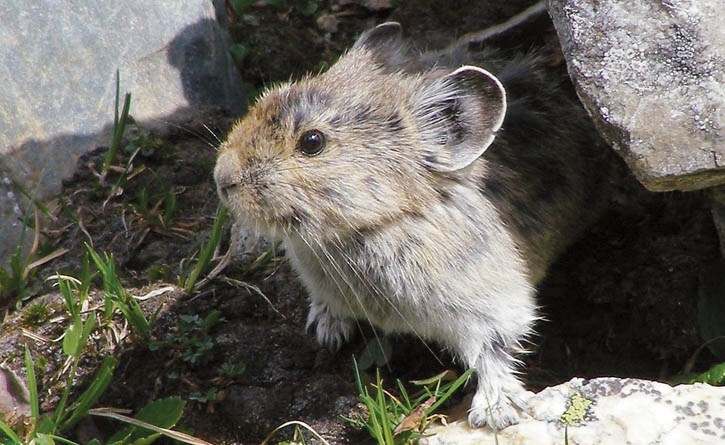New research suggests the American pika living high in the mountains of Alberta is very vulnerable to a changing climate – but there’s hope they won’t be at risk of disappearing as previously thought.
As part of an assessment by the Alberta Biodiversity Monitoring Institute of 173 species in Alberta, including birds, mammals and plants, the American pika ranked second in vulnerability only to Ord’s kangaroo rat, an endangered species in this province.
Wildlife biologist Chris Shank, who is co-author of the report Understanding and Respecting the Effects of Climate Change on Alberta’s Biodiversity, said pikas are vulnerable, but climate change seems unlikely to place them at risk in Alberta by the end of the century.
That said, Shank said there are many caveats and that conclusion assumes there is sufficient future snow cover, meadow habitat and talus availability, and if little is done to curb greenhouse gas emissions, the situation for pikas worsens.
“If we’re serious about keeping pikas in Alberta, we need to reduce our greenhouse emissions for sure,” said Shank during a presentation of the Bow Valley Naturalists in Banff on Feb. 23.
“There’s no reason to panic whether climate change is going to destroy pikas in Alberta, but there’s a lot of unknowns and we have to continue monitoring pikas here to determine how they are doing.”
The solitary American pika, known for its high-pitched alarm call, typically lives on rocky talus slopes within alpine regions of the western United States and southwestern Canada. They don’t hibernate and pikas thrive in predictable cold and snowy places.
Pikas limit their time in open areas to reduce their chances of being taken by predators like birds of prey and, as a result, they rarely seek food more than eight to 10 metres from the security of their talus.
They collect, cut, dry and organize a stash of food made up of a variety of plants into what is referred to as hay piles, located under overhanging rocks, in crevasses, or in chambers beneath the snow.
In the United States, some research has indicated the pika is suffering because global warming has brought higher temperatures to their western mountain home. Pikas have already disappeared from more than one-third of their previously known habitat in Oregon and Nevada.
Using climate data specific to 114 pika locations in Alberta, primarily sites from the Bow Valley Naturalists’ High Elevation Localized Species (HELS) database, Shank examined whether future climatic conditions are likely to put Alberta pikas at risk.
Shank said mean summer temperature is the most significant predictor of what causes individual populations of pikas to be in trouble, though temperature is not the only determination of pika population persistence.
When consideration was being given to listing the pika as endangered in the U.S., he said the U.S. Fish and Wildlife Service used a mean summer temperature of greater than 16.5 C as the criteria for potential endangerment to pikas there.
Shank said future mean summer temperatures at almost all current pika locations in Alberta are not expected to exceed the threshold used by the U.S., and most will remain cooler than the current warmest site in Alberta.
He said the mean summer temperature in this region is about 9 C, and the warmest Alberta site was 12.5 C, which was, surprisingly, located near Sibbald Flats in Kananaskis Country.
Shank said most current sites have sufficient elevation within five kilometres to allow pika populations to migrate higher up the mountains to maintain temperatures below that of the currently warmest Alberta site.
“We all know when you climb a mountain it gets colder, and around here in the summer it’s about 6 C per 1,000 feet,” he said.
“A pika which is experiencing thermal stress from an increased mean summer temperature can presumably move upslope, but it can only go that far before there’s nothing there.”
If it’s business as usual and nothing is done to reduce greenhouse gas emissions, Shank said about 70 per cent of locations in Alberta will remain below the temperature threshold by 2050.
“However, with this emissions scenario, the bad news is by the end of the century only 35 per cent will maintain current conditions of mean summer temperature and three of those 114 sites will actually be higher than the U.S. Fish and Wildlife Service criteria,” he said.
David Hik, a biologist in the department of biological sciences at the University of Alberta, said emerging research shows pikas seem adaptable to different elevations, diets and environmental conditions.
“My feeling is they are pretty resilient and, within the range of variation we expect in the next century, they’ll probably be fine and be able to move upslope,” said Hik.
“They can actually cope with pretty wide ranging conditions and variability. They’ve been around for a long time, through multiple glacial cycles, and yet are fairly widely distributed.”
Hik said temperature is a good index to measure future vulnerability of pikas in the long-term, but said what seems to cause declines in populations in the short-term is the absence of winter snow, compounded by increasing rain-on-snow events.
He said a study of Collared pikas in Yukon found warm winters without snow and with mid-winter rain were what best explained the periodic decline of pika populations, noting they declined there by 90 per cent in 2000-08, but increased again with good winters.
“My concern is what’s going to happen with winter snowfall, and in much of their range, that could effect their populations in the short-term,” said Hik.
“They don’t hibernate in winter, they are active, they have hay piles, and they rely on snow for protection from the larger changes in air temperatures,” he added.
“That space beneath the snow provides thermal insulation, and if you take that away they’re exposed to much more extreme temperatures.”




